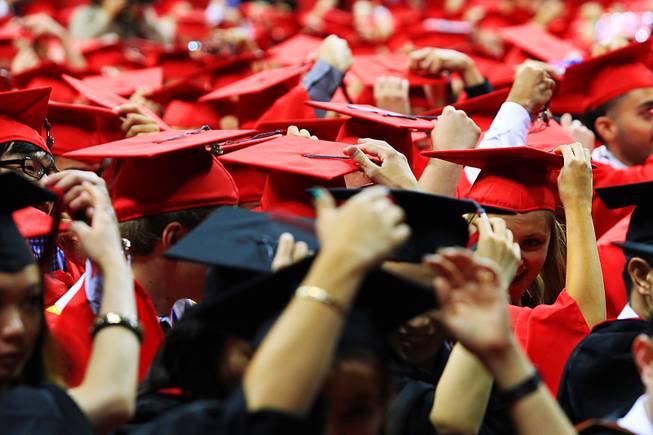Wednesday, Dec. 4, 2013 | 9:01 a.m.
Top 10 “High-debt” States
1. Delaware - average student loan debt: $33,649
2. New Hampshire - $32,698
3. Pennsylvania - $31,675
4. Minnesota - $31,497
5. Rhode Island - $31,156
6. Iowa - $29,456
7. Maine - $29,352
8. New Jersey - $29,287
9. Ohio - $29,037
10. Michigan - $28,840
Top 10 “Low-debt” States (including Washington, D.C.):
42. Louisiana - average student loan debt: $22,789
43. Kentucky - $22,384
44. District of Columbia - $22,384
45. Tennessee - $21,775
46. Utah - $21,520
47. Wyoming - $21,241
48. Nevada - $20,568
49. Arizona - $20,299
50. California - $20,269
51. New Mexico - $17,994
Nevada’s college graduates have among the lowest student loan debt in the country, according to a national report released Wednesday.
For the past eight years, the Institute for College Access and Success — a nonprofit organization studying college affordability — has issued reports on the student loan debt of recent graduates from four-year, public and private nonprofit colleges. The annual reports have not included for-profit colleges, because so few of them submit the necessary financial aid data.
About four in 10 Nevada college seniors graduated last year with student loan debt averaging $20,568, according to TICAS’ class of 2012 report, which used data from Sierra Nevada College, UNLV and UNR.
Although that’s a lot of debt, Nevada students have lower debt than most. Nationally, seven in 10 college graduates last year had student loan debt averaging $29,400.
In fact, Nevada has the fourth lowest average student loan debt among the 50 states and Washington, D.C., according to the report.
Average student loan debt ranged from $17,994 in New Mexico to $33,649 in Delaware. In general, the high-debt states were concentrated in the Northeast and Midwest states, while low-debt states were mainly located in the West and South.
Although Nevada students have among the lowest student loan debt nationally, state budget cuts have led to sharp tuition increases at Nevada colleges. At UNLV, tuition has increased by more than 70 percent since the recession, increasing students’ need to borrow money for tuition and living expenses.
About half of UNLV students graduate with student loan debt averaging about $21,000, according to the report. About a third of UNLV’s more than 16,000 full-time students receive federal student loan assistance. A little less than 10 percent of UNLV students use private loans — which often have higher interest rates — to pay for college.
Over the years, the nation’s student loan debt has risen to $1.2 trillion — more than the nation’s credit card debt. President Barack Obama has urged for more federal funding for financial aid assistance and a new “best value” college rating system that would rank universities on their affordability and academics.
The federal government also has introduced income-based loan repayment and loan forgiveness programs to help college graduates with their student loan debt. Income-based programs cap graduates’ loan payments as a percentage of their annual income. Loan forgiveness programs eliminates student loan debt after 20 years for eligible participants.
Last year, the federal government introduced college “scorecards,” or a shopping price sheet, to give potential students a better idea of how much money they will need to attend certain colleges. All colleges are now required to have a “net price calculator” on their websites to help students estimate their annual tuition and living expenses at school.
For more information about Nevada colleges and their average student loan debt, visit here.


Join the Discussion:
Check this out for a full explanation of our conversion to the LiveFyre commenting system and instructions on how to sign up for an account.
Full comments policy